To effectively institute change with minimal resistance, it is essential to spend more time training the heart. This has to do with attitudes that drive performance. To train the brain is to expose the trainees to new and evolving knowledge about their functions and corporate operations. Such knowledge must now translate into skills that are brought to bear on the productivity process. More often than not, this order is reversed. In reality, knowledge or skills acquisition alone are not sufficient to produce a highly effective worker. People only do well what they have become. The best of skills with no buy-in from the team will still sabotage the best intentions of any leader. The change pioneer must therefore concentrate adequate time and resources to attitudinal issues. Beyond that, he himself must be a rabid learner. According to Alvin Tuffler, “the illiterate of the 21st century will not be those who cannot read and write, but those who cannot learn, unlearn and relearn”
The Sermon On the Mount in Matthew 5 & 6, is not just a piece of eclectic homiletics. It is the manuscript of a training session that Jesus held for His disciples on attitudinal change and re-orientation of perception!
The next critical factor is Innovation. It has been said that the moment any organization begins to dance to the mantra of “We have never done it this way before and we should not start now”, it is already singing its swan-song. The swan is said to sing only once in its lifetime. And that is when it is about to die! A refusal to innovate is an invitation to corporate funeral.
Every new idea appears ridiculous and unthinkable at the onset. Yet therein lies its strength. The innovative spirit looks at present success as the greatest disservice to future attainment. So, innovators constantly shift boundaries in thinking and in possibilities. This is why professionalism is one of the greatest impediments to innovation. According to George Bernard Shaw, “All great truths begin as blasphemies”. When Jesus began to make postulations about the Kingdom of God and His relationship with the Father God, the Pharisees, the “professional” custodians of religion at that time, labelled Him a heretic and even went as far as branding Him demon-possessed!
Innovators are however never afraid of being labelled or sanctioned. Steve Ross, late CEO of the entertainment giant Warner Bros, told his staff, “In this company, you will be fired for not making mistakes!” The problem however, according to Dee Hock, the creator of Visa, “is never how to get new, innovative thoughts into your mind but how to get old ones out”! The leader of change must encourage everyone on his team to think on their feet. The team must be an idea bank, a repository of concepts sometimes considered out of this world or improbable but never ignored!
The change driver must also master the art of Networking. In building a virile network, the vision must always determine the quality and quantum of relationships. There are two pivotal questions in networking. The first is ‘Who needs us?’ The second is ‘Who do we need?’ Technology can never eliminate the need for people. Today, technology has enhanced the way we function and the tendency is to relate more with people through machines and gadgets (social networking). Good and convenient as these may seem, it must never become a substitute for flesh and blood relationships. Great business alliances are known to have been forged over a game of golf or a chance meeting at a business or club dinner. Multi-million dollar deals have been negotiated around a drink. Consequently, the leader’s network must be both intra-organizational and inter-organizational. Leaders of change learn to build strong alliances both at work and outside of work. Nothing in a network is sacrosanct or cast in iron. As the vision evolves, so must the network. If the current circle of relationship can no longer meet the demands of the future, the leader should have no qualms in tinkering with it without damaging the goodwill built at the current level.
Finally, to make a difference, the leader must never lose sight of the Task. In initiating change, all of the leaders actions must be guided by the assignment to be accomplished rather than the process to follow. The necessity for change arose because the present capacity became insufficient in arriving at a projected destination. That destination is the most important thing in the mind of the driver of change. It is not about change for change’s sake. It is about change for a purpose. Consequently, systems and structures as well as processes that do no service to that destination make themselves instantly expendable! No doubt it takes guts and can be risky. But it is never quite as risky as the alternative.
Those who refuse to change will be changed; I mean replaced!
Remember, the sky is not your limit, God is!






